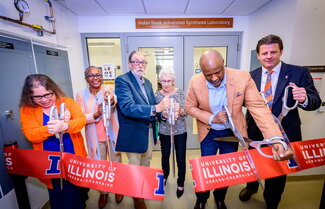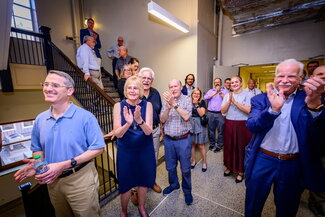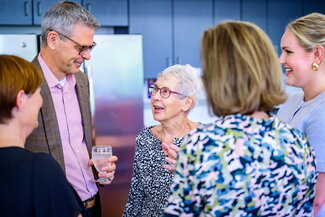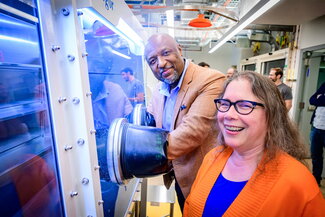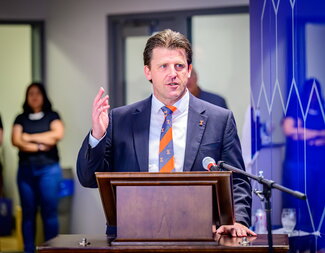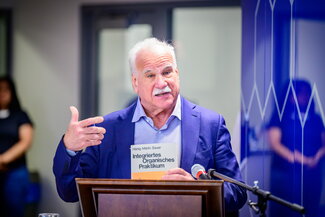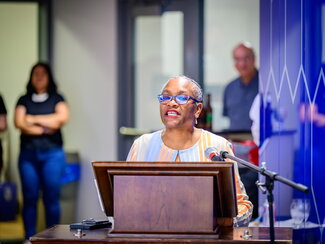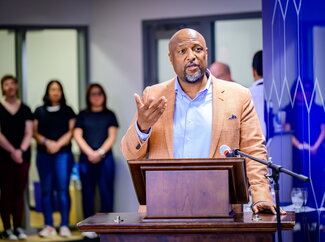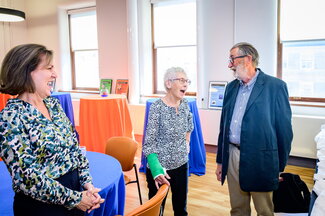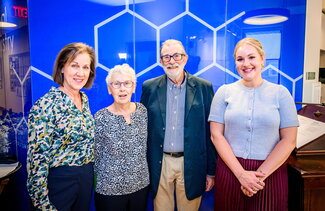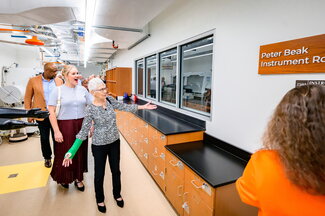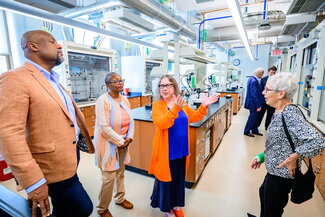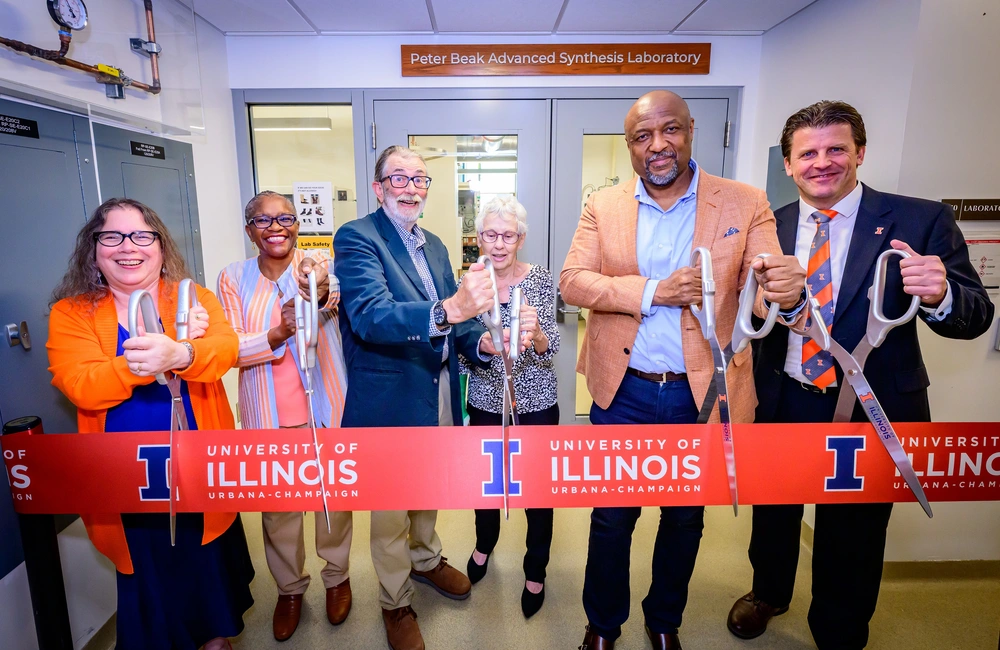
A fully renovated chemistry instructional facility in Noyes Laboratory has officially been dedicated the “Peter Beak Advanced Synthesis Laboratory” in memory of long-time chemistry Professor Peter A. Beak.
Family, friends, and former colleagues of Prof. Beak joined university officials, faculty, and staff in dedicating the modernized lab in a special ceremony on Sept. 29, 2025, that featured a ribbon cutting and remarks from special guests, including Prof. Beak’s wife, Sandra Beak. Signs at the entrance to the second-floor facility acknowledge the lab’s namesake and feature his photo and a short biography describing his impact on science, his colleagues, and his students.
Prof. Beak’s impact on one student motivated him to commemorate Beak. Illinois chemistry alumnus Michael Garst (BS, ‘69) made a gift to the Department of Chemistry in support of the lab renovation project and asked that the newly renovated space be named in memory of his professor and mentor.
During remarks before the ribbon cutting ceremony on Sept. 29, Garst said his professional start in life certainly comes back to the University of Illinois.
“And although I had many tremendous classes and I can remember several lecturers, the person who really was my mentor and gave me my professional start was Peter Beak,” said Garst, who participated in undergraduate research in Beak’s lab.
After that experience, Garst changed his plans for medical school, earned his PhD in chemistry and went on to a long and successful career in the chemical sciences.
“Whenever I'd stop and see Peter and talk to him about anything, he would give me great advice. And I think it's very easy to say, Peter is my professional father, without a doubt,” Garst said.
Mrs. Beak, accompanied by her daughter, Stacey Beatty, and her granddaughter, Keira Beatty, spoke at the ceremony and shared a comment that Prof. Beak once made when asked what area of his research was most rewarding.
“Peter never mentioned his significant contributions to chemistry. He always said it was working with my students. The opportunity to work and learn and be with part of their development was a privilege to him,” Mrs. Beak said. “Thank you again for the opportunity to celebrate such an exciting day with you all. I look forward to the amazing work that's going to be done in this beautiful state-of-the-art lab.”
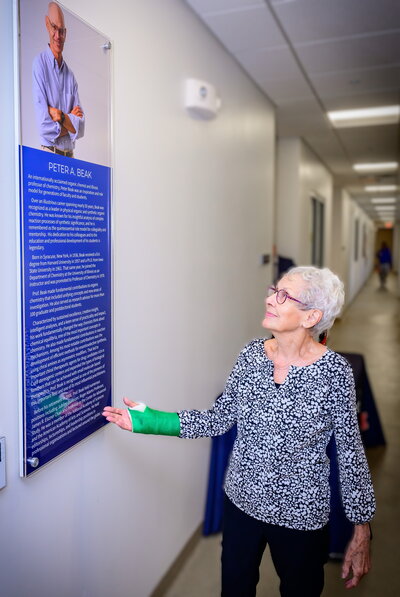
A leader in physical organic and synthetic organic chemistry and an Illinois faculty member for 48 years, Beak joined the Department of Chemistry at Illinois as an instructor in 1961 and was promoted to Professor of Chemistry in 1970. He passed away in 2021.
Catherine J. Murphy (BS, ‘86), Larry R. Faulkner Endowed Chair in Chemistry, and Head of the Department, shared in her dedication remarks that she was a student in Prof. Beak’s organic chemistry class in 1984.
“I remember him as a skilled and engaging teacher, and I enjoyed his class. The lab section of that organic class that Peter taught for so many years is one of the courses that will be housed in this new lab dedicated in his memory. I believe he would be pleased, not because the lab bears his name, but because it will offer a vastly improved learning environment for our students,” Murphy said.
Scott Denmark, Reynold C. Fuson Professor of Chemistry, was involved in upgrading the curriculum and laying out the vision for the new laboratory facility. In his remarks, he recognized the efforts of many people who were involved over many years in the design and planning of the Peter Beak Advanced Synthesis Laboratory. Denmark thanked the Provost’s Office, the College of LAS, the School of Chemical Sciences, donors, and others.
“We're very grateful to those various units and their leaders for allowing us to proceed with this project,” Denmark said.
Murphy said she is deeply grateful to the many individuals who contributed ideas, effort, and funding to bring this important project to life.
“I am especially grateful to fellow Illinois chemistry alum Michael Garst and his wife, Patricia Donahue. We are immensely grateful for your support of this project and excited to join you today in dedicating this lab in Peter Beak’s memory,” Murphy said.
Venetria K. Patton, Dean of the College of Liberal Arts and Sciences, said the newly renovated laboratory is an excellent example of the type of world-class facility that is critical to our individual and collective success in education, research, and innovation.
“Here, chemistry students engage in the type of hands-on learning that is a vital step in their preparation for successful high-impact careers. It's through such transformative learning experiences that LAS students discover how much they are capable of and what a significant impact they can make in our own world. This project is an investment in the curiosity, drive, and infinite potential of our amazing faculty and students,” Patton said.
In his remarks, Chancellor Charles L. Isbell Jr. expressed his thanks to Garst and Donahue, and said their generosity made possible this laboratory that will help position Illinois at the forefront of chemical science education for many years to come.
“One of the things that I've come to accept… is that immortality is not just living for a very long time. Immortality is having an impact on the people around you and the people you will never see,” Isbell said. “What we're celebrating… are a series of good ancestors, an ancestor who we are naming this laboratory after and an alumnus and friend who are investing in this future.”
Isbell said there are many people who will be able to take advantage of that investment and share what it means to do chemistry, what it means to think, what it means to learn, what it means to educate the generations to come.
“This is not a small thing. This is an important thing. And it is right and just that we take a moment to reflect on it and think about what we are doing for the people who have yet to ever step foot on this campus,” he said.
